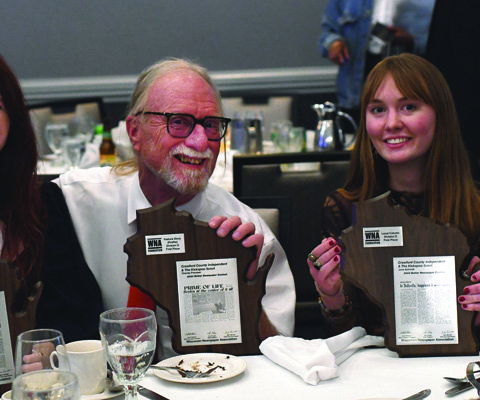It was a beautiful day in Prairie du Sac on Saturday, Jan. 18, for the annual Eagle Watching Days. The sun was shining, temperatures moderate for January, and the streets were alive with citizens out to enjoy the chance to view eagles along the Wisconsin River and learn more about them.
Among the variety of activities, aimed at the old and young alike, was a talk at the Tripp Heritage Museum by Art and Dawn Shegonee. The talk, attended by 40 citizens, aimed to explain the cultural and spiritual significance of eagles for indigenous people.
Art Shegonee opened his remarks with a bit of humor.
“How many Packers fans do we have in the audience,” Shegonee asked. “I’ve been thinking about becoming an Eagles fan,” he joked.
Dawn Shegonee explained that she had met her husband at a boat landing in northern Wisconsin during the times when Native Americans were exercising their rights guaranteed by treaty with the U.S. government to engage in spear fishing. Dawn Shegonee appeared at the Prairie du Sac event wearing cowboy boots, and her husband a ribboned shirt, common among native peoples.
"We call ourselves a ‘Cowgirl Indian - Unlikely Alliance’," Dawn Shegonee said with a smile.
Art Shegonee is a member of both the Menominee and Potawatomi tribes. Both tribes are federally recognized in the State of Wisconsin.
The two formed the ‘Call for Peace Drum & Dance Company,’ dedicated to “taking you on a historical, transformational journey, creating a new common memory of our interconnectedness with unity, justice, hope and discovery.” They represent seven Multicultural dance company directors, coming together in performing a circle dance of unity called, ‘Dancing the Dream, A New Hope For Humanity.’
Eagles and spirituality
The Shegonees showed participants at their talk a video of a recent eagle release ceremony that had taken place earlier in January in Prairie du Sac. The release was conducted by the ‘Raptor Education Group,’ a non-profit organization formed by Marge and Don Gibson. During the release, Shegonee blessed the rehabilitated eagles being released in a traditional Native American ceremony.
“Marge is an awesome person for the work that she does in caring for injured eagles,” Shegonee said. “She tells me that it costs 1,000s of dollars per eagle to get them the medicine they need, keep them safe and warm, and ensure they are cared for properly.”
Marge has worked with wildlife for over 30 years, and began her work with raptors as a field biologist. She has worked with many high profile field projects, including the California Condor Recovery Team and the Bald Eagle Capture and Health Assessment Program in Valdez, Alaska, following the Valdez Oil Spill, where she was team captain.
“For Native Americans, eagles are messengers of hope, and our prayers are carried on their wings to the creator,” Shegonee explained. “For us, eagles represent the travel between the physical and the spiritual world.”
Shegonee said that Native Americans who are confirmed in their tribal identity are the only citizens allowed to possess eagle feathers. For everyone else, it is illegal to possess feathers or any other part of an eagle.
“Eagles are often killed when they are attempting to eat dead animals on the side of the road,” Shegonee explained. “When an eagle is killed, then their body becomes the property of the DNR, and Native Americans can obtain our feathers from them, from the birds that have been killed.”
Unlikely alliance
The Shegonee’s dance company is dedicated to the idea that a new people will emerge when the water is poisoned, so that the people can no longer eat the fish.”
“We will have a choice between two roads,” Shegonee explained. “One is the road of the unsustainable technology of greed, and the other the road to spirituality where there is reverence for all life and the planet. All things are connected.”
Shegonee said he was inspired by Nick Hockings, a member of the Lac du Flambeau Band of Lake Superior Chippewa Indians. Hockings had a clear vision of hope for the future. He passed away in 2012, but his impact continues. He said we live in a time when “we’ll begin to understand our relationship once again to the environment, our relationship... more importantly, to one another. And we’ll realize that as relatives that this... is a time when we’ll begin to come together.”
“We worked with Nick to form the dance troupe as a way for Native Americans to be able to tell our story ourselves,” Shegonee said. “For us, everything on the Earth is holy in the memory of our people. We are part of the Earth, and the Earth is part of us. Teach your children that what befalls the Earth befalls the children of the Earth. We did not weave the web of life, we are merely a strand in it.”
Shegonee’s ‘call for peace,’ is expressed through the Chippewa word, ‘Osh-ki-bi-ma-di-zeeg,’ which means “a new people.” It relates to a prophecy by Chief Seattle.
“When the water turns to poison and we can no longer eat the fish, that’s when a new people will emerge,” Shegonee quoted. “That’s who you are.”
Upcoming events
At the beginning of the presentation, John Hart of the Sauk Prairie Historical Society let attendees know about upcoming events planned at the Tripp Heritage Museum:
• April 28: Dr. Patrick Jung will discuss the Battle of Wisconsin Heights, and lead a tour of the site of the battle
• November 2025: a presentation will be made about how a grade school student found the skull of a bison below the Prairie du Sac Dam on the Wisconsin River during a time of low water twenty years ago. The skull is part of the Tripp Heritage Museum’s collection.






